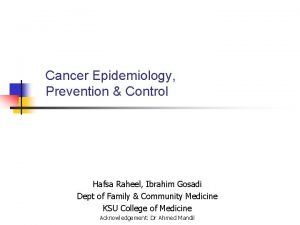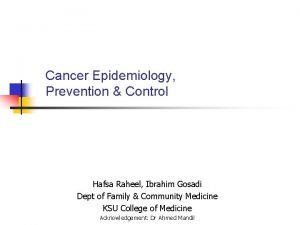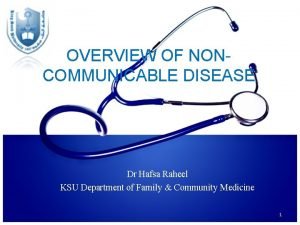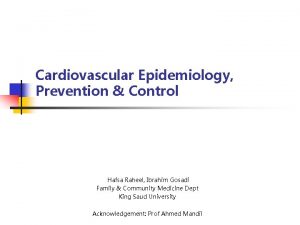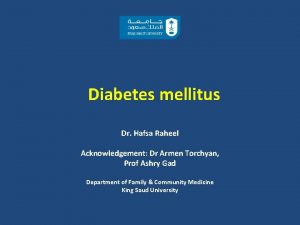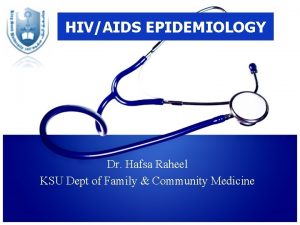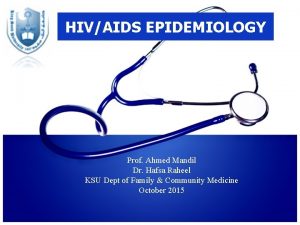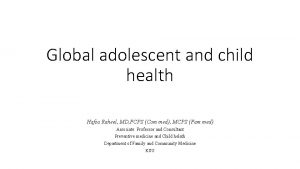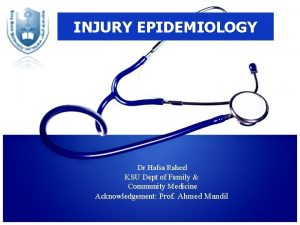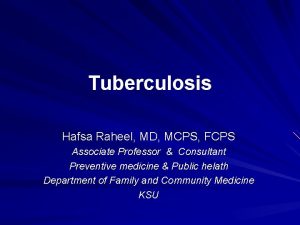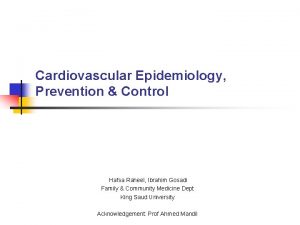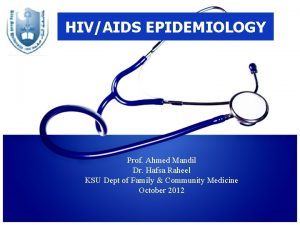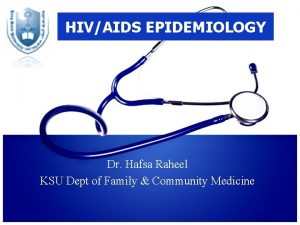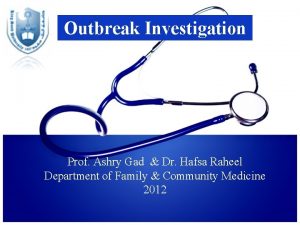Risk factors for NCDs Hafsa Raheel MD FCPSCOM


































































- Slides: 66

Risk factors for NCDs Hafsa Raheel MD, FCPS(COM MED), MCPS (FAM MED) Associate Professor & Consultant Preventive Medicine and Public health Department of Family and Community Medicine College of Medicine The slides have been adopted from WHO website on NCDs

Objectives of the session Define selected risk factors such as; tobacco use, diet, nutrition, physical activity, obesity, ad overweight Present the epidemiology and significance of the risk factors globally and in KSA Discuss high risk populations and consequences of the NCD risk factors Enlist screening methods for these risk factors Discuss examples of evidence based interventions to prevent and control these risk factors

Types of NCDs • • Cardiovascular disease (e. g. , Coronary heart disease, Stroke) Cancer Chronic respiratory disease Diabetes Chronic neurologic disorders (e. g. , Alzheimer’s, dementias) Arthritis/Musculoskeletal diseases Unintentional injuries (e. g. , from traffic crashes) http: //www. who. int/gho/ncd/mortality_morbidity/en/index. html Overview of NCD’s and Risk Factors 3

Risk Factor: Definition “An aspect of personal behavior or lifestyle, an environmental exposure, or a hereditary characteristic that is associated with an increase in the occurrence of a particular disease, injury, or other health condition. ” Principles of Epidemiology, CDC, 2006 Overview of NCD’s and Risk Factors 8

Modifiable Risk Factor • A behavioral risk factor that can be reduced or controlled by intervention, thereby reducing the probability of disease. • WHO has prioritized the following four: ‒ Physical inactivity, ‒ Tobacco use, ‒ Alcohol use, and ‒ Unhealthy diets (increased fat and sodium, with low fruit and vegetable intake). http: //www. who. int/nmh/events/2012/discussion_paper 3. pdf Overview of NCD’s and Risk Factors 5

Non-Modifiable Risk Factor A risk factor that cannot be reduced or controlled by intervention; for example: • Age, • Gender, • Race, and • Family history (genetics). Overview of NCD’s and Risk Factors 6

Common Risk Factors Overview of NCD’s and Risk Factors 7

Metabolic Risk Factors • • • “Metabolic" refers to the biochemical processes involved in the body's normal functioning Behaviors (modifiable risk factors) can lead to metabolic/physiologic changes. WHO has prioritized the following four metabolic risk factors: ‒ ‒ Raised blood pressure Raised total cholesterol Elevated glucose Overweight and obesity http: //www. who. int/nmh/events/2012/discussion_paper 3. pdf Overview of NCD’s and Risk Factors 8

FOUR LEADING NCDs Overview of NCD’s and Risk Factors 9

WHO Website Global Health Observatory (GHO): http: //www. who. int/gho/en/ • Provides data and analyses on global health priorities • Noncommunicable diseases ‒ Mortality/morbidity ‒ Risk Factors • Country statistics: health data and statistics for countries Media centre fact sheets: http: //www. who. int/mediacentre/factsheets/en/ • Key facts • Symptoms • Risk factors • Burden of disease Overview of NCD’s and Risk Factors 10

Cardiovascular Disease: Definition • Cardiovascular disease (CVD) is a group of disorders of the heart and blood vessels, and may include: Coronary heart disease Disease of the blood vessels supplying the heart muscle Cerebrovascular disease (Stroke) Disease of the blood vessels supplying the brain Peripheral arterial disease Disease of blood vessels supplying the arms and legs Congenital heart disease Malformations of heart structure existing at birth Overview of NCD’s and Risk Factors 11

Global Burden of Cardiovascular Disease • CVDs are the #1 cause of death globally. • An estimated 17. 3 million people died from CVDs in 2008. (30% of all global deaths) • 7. 3 million were due to coronary heart disease • 6. 2 million were due to stroke • Over 80% CVD deaths occur in low- and middle- income countries. • By 2030, almost 25 million people will die from CVDs. http: //www. who. int/cardiovascular_diseases/en/ Overview of NCD’s and Risk Factors 12

Cardiovascular Disease: Risk Factors Major modifiable risk factors -High blood pressure -Abnormal blood lipids -Tobacco use -Physical inactivity -Obesity -Unhealthy diet (salt) -Diabetes Other modifiable risk factors -Low socioeconomic status -Mental ill health (depression) -Psychosocial stress -Heavy alcohol use -Use of certain medication -Lipoprotein(a) Non-modifiable risk factors -Age -Heredity or family history -Gender -Ethnicity or race “Novel” risk factors -Excess homocysteine in blood -Inflammatory markers (Creactive protein) -Abnormal blood coagulation (elevated blood levels of fibrinogen) Overview of NCD’s and Risk Factors 13

Diabetes: Definition • Diabetes is a disorder of metabolism— the way the body uses digested food for growth and energy. • There are 4 types: Type 1, Type 2, Gestational, and Pre-Diabetes (Impaired Glucose Tolerance). • Type 2 is caused by modifiable risk factors and is the most common worldwide. • >90% of all adult diabetes cases are Type 2 1. http: //www. who. int/mediacentre/factsheets/fs 312/en/ 2. National institute of Diabetes and Digestive and Kidney Diseases, 2012 Overview of NCD’s and Risk Factors 14

Diabetes: Burden of Disease • 347 million people worldwide have diabetes. • In 2004, an estimated 3. 4 million people died from consequences of high blood sugar. • More than 80% of diabetes deaths occur in low- and middle-income countries. • WHO projects that diabetes deaths will increase by two thirds between 2008 and 2030. • Healthy diet, regular physical activity, maintaining a normal body weight and avoiding tobacco use can prevent or delay the onset of type 2 diabetes. 1. http: //www. who. int/mediacentre/factsheets/en/ 2. http: //www. idf. org/regions Overview of NCD’s and Risk Factors 15

Diabetes: Risk Factors Major modifiable Risk Factors -Unhealthy diets -Physical Inactivity -Obesity or Overweight -High Blood Pressure -High Cholesterol Other Modifiable Risk Factors -Low socioeconomic status -Heavy alcohol use -Psychological stress -High consumption of sugarsweetened beverages -Low consumption of fiber Non-modifiable Risk Factors -Increased age -Family history/genetics -Race -Distribution of fat Other Risk Factors -Low birth weight -Presence of autoantibodies Overview of NCD’s and Risk Factors 16

Cancer: Definition • Generic term for a large group of diseases that can affect any part of the body. • “Rapid creation of abnormal cells that grow beyond their usual boundaries, and which can then invade adjoining parts of the body and spread to other organs. ” (WHO, 2012) • Benign tumors • Malignant tumors Overview of NCD’s and Risk Factors 17

Global Burden of Cancer • 7. 6 million people died from cancer in 2008. • 70% of all cancer deaths occur in low- and middleincome countries. • Deaths from cancer are estimated to reach 13. 1 million by 2030. • About 30% of cancers are attributable to behavior risk factors. http: //www. who. int/mediacentre/factsheets/fs 297/en/index. html Overview of NCD’s and Risk Factors 18

Cancer Epidemiology Estimated age-standardised incidence and mortality rates: total population http: //globocan. iarc. fr/ Overview of NCD’s and Risk Factors 19

Cervical Cancer Estimated age-standardised rates (World) per 100, 000 http: //globocan. iarc. fr/ Overview of NCD’s and Risk Factors 20

Cervical Cancer: Risk Factors • • • Human papilloma virus infection (HPV) Smoking Immune Deficiencies Poverty No access to PAP screening Family history of cervical cancer Overview of NCD’s and Risk Factors 21

Lung Cancer: Definition • • Cancer that forms in tissues of the lung, usually in the cells lining air passages Leading cause of cancer death globally, 1. 37 million deaths in 2008 Affects more men than women Two main types: ‒ Small cell lung cancer ‒ Non-small cell lung cancer Overview of NCD’s and Risk Factors 22

Lung Cancer Incidence and Mortality in 2008: Both Sexes Source: http: //globocan. iarc. fr/ Overview of NCD’s and Risk Factors 23

Lung Cancer: Risk Factors • • • Smoking cigarettes, pipes, or cigars - now or in the past Being exposed to second-hand smoke Being treated with radiation therapy to the breast or chest Being exposed to asbestos, radon, chromium, nickel, arsenic, soot, or tar Living where there is air pollution Overview of NCD’s and Risk Factors 24

Breast Cancer: Definition • Cancer that forms in the tissues of the breast, usually in the ducts or in the lobules • Occurs commonly in women, rarely occurs in men • 1 of 8 women will be diagnosed with breast cancer in her lifetime. Overview of NCD’s and Risk Factors 25

Breast Cancer Incidence and Mortality in 2008: Both Sexes http: //globocan. iarc. fr/ Overview of NCD’s and Risk Factors 26

Breast Cancer: Risk Factors • • Hormone therapies Weight and physical activity Race Genetics or family history ‒ BRCA 1 and BRCA 2 genes • Age is the most reliable risk factor! ‒ Risk increases with age Overview of NCD’s and Risk Factors 27

Colorectal Cancer • • • 3 rd most common type of cancer Forms in the lower part of the digestive system (large intestine) Risk Factors include: ‒ ‒ ‒ Aging Black race Unhealthy diet and low exercise Diabetes Family history of colorectal cancer http: //www. mayoclinic. com/health/colon-cancer/DS 00035 Overview of NCD’s and Risk Factors 28

Colorectal Cancer Incidence and Mortality in 2008: Both Sexes http: //globocan. iarc. fr/ Overview of NCD’s and Risk Factors 29

CHRONIC RESPIRATORY Overview of NCD’s and Risk Factors 30

Global Burden of Chronic Respiratory Disease • • • A leading cause of death High under-diagnoses rates 90% of deaths occur in low-income countries http: //www. who. int/respiratory/about_topic/en/index. html Overview of NCD’s and Risk Factors 42

Chronic Respiratory Diseases: Shared Risk Factors Genes Infections Socio-economic status Aging Populations http: //www. goldcopd. org/other-resources-gold-teaching-slide-set. html Overview of NCD’s and Risk Factors 32

Why Risk Factors? • Surveillance for non-communicable disease can be difficult because of: • Lag time between exposure and health condition, • More than one exposure for a health condition, and • Exposure linked to more than one health condition. • Interventions that target risk factors are needed to prevent disease. Overview of NCD’s and Risk Factors 33

Risk Factor Surveillance Overview of NCD’s and Risk Factors 34

Deaths attributed to 19 leading risk factors, by country income level, 2004 WHO Global Health risks report Overview of NCD’s and Risk Factors 35

Tobacco Use • Tobacco kills up to half of its users. • Tobacco kills nearly 6 million people each year. • Annual death toll could rise to more than 8 million by 2030. • Nearly 80% of the world’s 1 billion smokers live in low- and middle-income countries. http: //www. who. int/mediacentre/factsheets/fs 339/en/index. html Overview of NCD’s and Risk Factors 36

Global Adult Tobacco Survey http: //www. cdc. gov/tobacco/global/gtss/tobacco_atlas/index. htm Overview of NCD’s and Risk Factors 54

DIET Overview of NCD’s and Risk Factors 38

Global Changes in Diet • Most countries have increased overall daily consumption of: • Daily calories, • Fat and meats, and • Energy dense and nutrient-poor foods such as: ‒ Starches ‒ Refined sugars ‒ Trans-fats http: //www. pitt. edu/~super 4/4101142001/41171. pdf Overview of NCD’s and Risk Factors 39

Unhealthy Diet: Health Effects • • Coronary heart disease Stroke Cancer Type 2 diabetes Hypertension Diseases of the liver and gallbladder Obesity Overview of NCD’s and Risk Factors 40

PHYSICAL INACTIVITY Overview of NCD’s and Risk Factors 41

Global Changes in Physical Activity • 31% of the world’s population does not get enough physical activity. • Many social and economic changes contribute to this trend: • Aging populations, • Transportation, and • Communication technology. 1. http: //www. cdc. gov/physicalactivity/everyone/guidelines/adults. html 2. http: //www. sciencedirect. com/science/article/pii/S 0140673612608988 Overview of NCD’s and Risk Factors 42

Global Changes in Physical Activity (cont. ) Lee IM, Shiroma EJ, Lobelo F, Puska P, Blair SN, Katzmarzyk PT; Lancet Physical Activity Series Working Group. Effect of physical inactivity on major non-communicable diseases worldwide: an analysis of burden of disease and life expectancy. Lancet. 2012 Jul 21; 380(9838): 219 -29 Overview of NCD’s and Risk Factors 62

Physical Activity: Health Effects Reduces: • High blood pressure • Adverse lipid profile • Arthritis pain • Psychiatric issues Reduces risk of: • Type 2 diabetes • Certain cancers • Heart attacks • Stroke • Falls • Early death http: //www. health. gov/paguidelines/factsheetprof. aspx Overview of NCD’s and Risk Factors 44

ALCOHOL USE Overview of NCD’s and Risk Factors 45

Global Alcohol Consumption • 11. 5% of all global drinkers are episodic, heavy users. • 2. 5 million people die from alcohol consumption per year • The majority of adults consume at low-risk levels. • Estimated worldwide consumption of alcohol has remained relatively stable. http: //www. who. int/substance_abuse/publications/global_alcohol_report/msbgsruprofiles. pdf Overview of NCD’s and Risk Factors 46

Global Alcohol Consumption http: //www. who. int/substance_abuse/publications/global_alcohol_report/en/index. html Overview of NCD’s and Risk Factors 47

Use of Alcohol: Definitions Excessive drinking, per day • Heavy drinking – on average > > • Binge drinking – single occasion ≥ Overview of NCD’s and Risk Factors ≥ 48

Alcohol Use: Effects Immediate effects: • Diminished brain function • Loss of body heat • Fetal damage • Risk for unintentional injuries • Risk for violence • Coma and death Overview of NCD’s and Risk Factors Long-term effects: • Liver diseases • Cancers • Hypertension • Gastrointestinal disorders • Neurological issues • Psychiatric issues 49

Metabolic Risk Factors What are the four metabolic risk factors? 1. Raised Blood Pressure (Hypertension) 2. Raised Cholesterol 3. Raised Blood Glucose 4. Overweight and Obesity Overview of NCD’s and Risk Factors 50

Raised Blood Pressure • Hypertension • (Systolic)/(Diastolic) in mm of Hg (mercury) • Systolic = amount of force your arteries use when the heart pumps • Diastolic = amount of force your arteries use when the heart relaxes Measurement Normal Pre-Hypertensive Systolic mm. Hg <120 120 -139 140+ Diastolic mm. Hg <80 80 -89 90+ Overview of NCD’s and Risk Factors 51

High Blood Pressure 1. US Department of Health & Human Services, National Heart, Lung, and Blood 2. http: //gamapserver. who. int/gho/interactive_charts/ncd/risk_factors/blood_pressure_prevalence/atlas. html Overview of NCD’s and Risk Factors 52

Raised Blood Pressure: Health Effects • • Leading risk factor for stroke Major risk factor for coronary heart disease In some age groups, the risk of CVD doubles for each increment of 20/10 mm. Hg of blood pressure Other complications of raised blood pressure: ‒ ‒ ‒ Heart failure Peripheral vascular disease Renal impairment Retinal hemorrhage Visual impairment Overview of NCD’s and Risk Factors 53

Hypertension and Excessive Sodium Intake • Sodium, through hypertension, is a major cause of cardiovascular disease deaths and disability. • About 10% of cardiovascular disease is caused by excess sodium intake. • 8. 5 million deaths could be prevented over 10 years if sodium intake were reduced by 15%. Overview of NCD’s and Risk Factors 54

Sources of Sodium • People are unaware of how much dietary sodium they are eating. • In the U. S. 75% of sodium consumed comes from processed and restaurant foods. • In China and Japan, 75% of sodium consumed comes from cooking with high sodium products. Overview of NCD’s and Risk Factors 55

• Recommendations and Actual Intakes Recommendations WHO/PAHO A population salt intake of less than 5 grams or • approximately 2, 000 milligrams of sodium, person per day is recommended to reach national targets or in their absence. This level was recommended for the prevention of cardiovascular diseases. • Actual Intake • Latest global estimates show that average sodium intake varies from 2, 000 to 7, 200 milligrams of sodium person per day. Overview of NCD’s and Risk Factors 56

Global Burden of Raised Total Cholesterol • In 2008, global prevalence of raised total cholesterol among adults (≥ 5. 0 mmol/l) was 39% (37% for males and 40% for females). • Estimated to cause 2. 6 million deaths. • What is the prevalence of raised total cholesterol in your country? • Search the WHO Global Health Observatory website: http: //www. who. int/gho/ncd/risk_factors/en/index. html Overview of NCD’s and Risk Factors 57

Raised Total Cholesterol: Health Effects • Increases risks of heart disease and stroke • Globally, 1/3 of ischaemic heart disease is attributable to high cholesterol • A 10% reduction in serum cholesterol in men aged 40 has been reported to result in a 50% reduction in heart disease within 5 years • A 10% reduction in serum cholesterol in men aged 70 years can result in an average 20% reduction in heart disease occurrence in the next 5 years http: //www. who. int/gho/ncd/risk_factors/cholesterol_text/en/ Overview of NCD’s and Risk Factors 58

Overweight and Obesity • Overweight and obesity are defined as ''abnormal or excessive fat accumulation that presents a risk to health. ” (1) • BMI - the Body Mass Index BMI = (weight in kg)/(height in meters, squared) - Between 25 and 29. 9 indicates overweight - 30 or higher indicates obesity • Skinfold Thickness Test • Waist-to-Hip Circumference Ratio ‒ Men > 102 cm are considered high risk ‒ Women > 88 cm are considered high risk 1. http: //www. who. int/dietphysicalactivity/childhood_what/en/index. ht Overview of NCD’s and Risk Factors 59

Overweight and Obesity: Global Burden • Worldwide, obesity has more than doubled since 1980. • In 2008, more than 1. 4 billion adults, 20 and older, were overweight. ‒ Of these, 200 million men and nearly 300 million women were obese. • 65% of the world’s population live in countries where the mortality associated with overweight and obesity is higher than the mortality associated with underweight. • Globally, in 2010 the number of overweight children under the age of five was estimated to be over 42 million. ‒ Close to 35 million of these are living in developing countries. http: //www. who. int/healthinfo/global_burden_disease/2004_report_update/en/index. html Overview of NCD’s and Risk Factors 60

Overweight and Obesity: Health Effects • Environment, lifestyle, genetics, and other factors contribute to each individual’s risk for being overweight or obese. • Increases risk of coronary heart disease, type 2 diabetes, and hypertension • Large economic consequences for many countries • Resource: http: //www. thelancet. com/series/obesity Overview of NCD’s and Risk Factors 84

2012 WHO Global Targets: Reducing Risk Factors http: //www. who. int/nmh/events/2012/4 November 2012_PPT_Rev. Paper_TA. pdf Overview of NCD’s and Risk Factors 62

Evidence based global interventions

World Health Organization. Global action plan for the prevention and control of noncommunicable diseases 20132020. http: //www. who. int/nmh/events/ncd_action_plan/en/. (cited 07 Mar 2016).

World Health Organization. Global action plan for the prevention and control of noncommunicable diseases 20132020. http: //www. who. int/nmh/events/ncd_action_plan/en/. (cited 07 Mar 2016).

Thank you Questions?
 Raheel choudhary
Raheel choudhary Hafsa riaz
Hafsa riaz 32 farzı bilmeyenin nikahı kıyılır mı
32 farzı bilmeyenin nikahı kıyılır mı Raheel choudhary
Raheel choudhary Liquidity measures
Liquidity measures Blomman för dagen drog
Blomman för dagen drog Redogör för vad psykologi är
Redogör för vad psykologi är En lathund för arbete med kontinuitetshantering
En lathund för arbete med kontinuitetshantering Mat för unga idrottare
Mat för unga idrottare Geometri för barn
Geometri för barn Claes martinsson
Claes martinsson Offentlig förvaltning
Offentlig förvaltning Etik och ledarskap etisk kod för chefer
Etik och ledarskap etisk kod för chefer Datorkunskap för nybörjare
Datorkunskap för nybörjare Plagg i rom
Plagg i rom Rita perspektiv
Rita perspektiv Vilken grundregel finns det för tronföljden i sverige?
Vilken grundregel finns det för tronföljden i sverige? Big brother rösta
Big brother rösta Förklara densitet för barn
Förklara densitet för barn Ministerstyre för och nackdelar
Ministerstyre för och nackdelar Sju principer för tillitsbaserad styrning
Sju principer för tillitsbaserad styrning Bat mitza
Bat mitza Nationell inriktning för artificiell intelligens
Nationell inriktning för artificiell intelligens Haiku 5-7-5 exempel
Haiku 5-7-5 exempel Nyckelkompetenser för livslångt lärande
Nyckelkompetenser för livslångt lärande Romarriket tidslinje
Romarriket tidslinje Datumr
Datumr Stål för stötfångarsystem
Stål för stötfångarsystem Personalliggare bygg undantag
Personalliggare bygg undantag Verktyg för automatisering av utbetalningar
Verktyg för automatisering av utbetalningar Vishnuismen
Vishnuismen Kyssande vind analys
Kyssande vind analys Exspektans eller expektans
Exspektans eller expektans Boverket ka
Boverket ka Strategi för svensk viltförvaltning
Strategi för svensk viltförvaltning Formel standardavvikelse
Formel standardavvikelse Informationskartläggning
Informationskartläggning Tack för att ni har lyssnat
Tack för att ni har lyssnat Vad står k.r.å.k.a.n för
Vad står k.r.å.k.a.n för Centrum för kunskap och säkerhet
Centrum för kunskap och säkerhet Läkarutlåtande för livränta
Läkarutlåtande för livränta Treserva lathund
Treserva lathund Inköpsprocessen steg för steg
Inköpsprocessen steg för steg Påbyggnader för flakfordon
Påbyggnader för flakfordon Tack för att ni lyssnade
Tack för att ni lyssnade Egg för emanuel
Egg för emanuel Atmosfr
Atmosfr Personlig tidbok
Personlig tidbok Rutin för avvikelsehantering
Rutin för avvikelsehantering Mitos steg
Mitos steg Presentera för publik crossboss
Presentera för publik crossboss Formuö
Formuö Myndigheten för delaktighet
Myndigheten för delaktighet Hur skriver man en tes
Hur skriver man en tes Kung som dog 1611
Kung som dog 1611 Tobinskatten för och nackdelar
Tobinskatten för och nackdelar Referatmarkering
Referatmarkering Shingelfrisyren
Shingelfrisyren Byggprocessen steg för steg
Byggprocessen steg för steg Ruin karttecken
Ruin karttecken Epiteltyper
Epiteltyper Tallinjen
Tallinjen Rbk mätning
Rbk mätning Formel för lufttryck
Formel för lufttryck Elektronik för barn
Elektronik för barn Tack för att ni har lyssnat
Tack för att ni har lyssnat Borra hål för knoppar
Borra hål för knoppar



































































